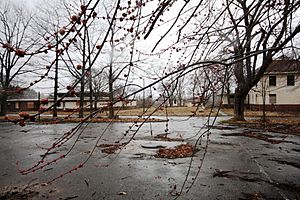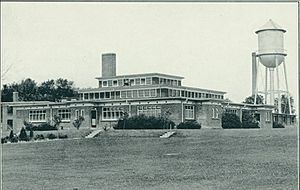Bowmanville POW camp facts for kids
The Bowmanville POW camp, also known as Camp 30, was a special place in Bowmanville, Ontario, Canada. During World War II, it was a POW camp where German soldiers were held by Canadian forces. In September 2013, this camp was recognized as a National Historic Site of Canada because of its important history.
One famous event at the camp was an escape attempt in 1943. It was called Operation Kiebitz. This plan tried to help two prisoners, Otto Kretschmer and Wolfgang Heyda, get away.
From School to Camp
The land where Camp 30 stood was first used for the Bowmanville Boys Training School. This school helped train boys and had its first buildings ready in 1927. It taught students for 14 years.
In 1941, the government told the school to move. They needed the area quickly to create a prisoner-of-war (POW) camp. The boys' school moved to a new spot in Bowmanville. Most of the boys went back home.
Canadian officials had only seven months to change the school into a POW camp. They had a lot to do! They built tall barbed-wire fences, nine guard towers, and new buildings for the Canadian guards. All these changes were finished by late 1941, just as the first prisoners arrived.
After World War II ended, the prisoners were sent back to Europe. The site then went back to being a school.
The Battle of Bowmanville
In October 1942, a big event happened at the camp. It's known as the "Battle of Bowmanville." Between 1,500 and 4,000 prisoners protested against the guards. This happened because some German prisoners were being "shackled," meaning their hands were tied together. This was a response to a new rule from Germany called the Commando Order.
Lieutenant-colonel James Taylor, a Canadian officer, asked a German officer named Georg Friemel for 100 prisoners to volunteer to be shackled. When Friemel refused, other German officers, Otto Kretschmer and Hans Hefele, also said no.
Taylor then ordered guards to find 100 officers to shackle by force. In response, prisoners like Horst Elfe and Kretschmer blocked themselves inside the mess hall. They used sticks, iron bars, and other items as makeshift weapons.
About 100 Canadian soldiers from another base arrived. They stormed the mess hall using only ice hockey sticks. This made the fight fair between the two sides. After hours of fighting, the Canadians used high-pressure water hoses. They soaked the building until the prisoners agreed to come out peacefully.
During other incidents over several days, one prisoner was hurt by a gunshot. Another prisoner was injured by a bayonet. A Canadian soldier also got a skull injury from a thrown jar of jam. After things calmed down, 126 prisoners were moved to other camps.
Escape Attempts
While it was a POW camp, there were many attempts to escape. Even though prisoners were often treated better than many people outside the camp, they still wanted to get away.
- The first escape happened soon after the camp opened, on November 23, 1941. A prisoner named Ulrich Steinhilper got through the wire. He was free for two days before being caught. He tried to escape two more times and was caught each time. After his last attempt in February 1942, he was moved to another camp.
- On November 25, 1941, another prisoner tried to crawl under the barbed wire. He was caught right away and held for 28 days.
- Operation Kiebitz was a famous failed escape plan. It aimed to rescue four German submarine commanders.
- On December 30, a prisoner tried to escape by hiding in a laundry truck as it left the camp. He was caught and held in the Oshawa Jail for a few hours. He was then returned to the camp the same day.
- During a check of the prisoners' cells on July 29, 1943, guards found a tin can. It had a map and tools meant for an escape. The can was taken away.
- The most well-known escape attempts involved prisoners trying to dig tunnels. Several tunnels were started. When found, they were stopped and closed. The most famous tunnel was started in the North-east corner of Victoria Hall. Prisoners called this building "Haus IV." The tunnel was small, about 50cm by 50cm. It even had lights and a ventilation system made from tin cans. Wooden supports from the camp's attics held up the tunnel every 1-2 meters. Dirt from the tunnel was moved using a trolley system. Men passed buckets of dirt up to the attic through a hole in the ceiling. In September 1943, the attic floor broke because of all the dirt. Guards found the tunnel and collapsed it.
Camp 30 Today
The property continued as a boys' training school until 1979. After that, it was used for different schools until 2008. These included a school for Malaysian students, St. Stephen's Catholic Secondary School, and a private Islamic university.
Today, Camp 30 is largely neglected. Many buildings are boarded up, and windows are broken. The insides of the buildings are damaged with graffiti and smashed drywall. Most buildings are considered dangerous or a fire risk. However, some parts are still in good condition.
In 2013, Camp 30 was put on Heritage Canada's list of 'The top 10 endangered places.' This was because it was planned to be torn down due to its poor state. However, this demolition plan was stopped later in 2013. This happened after it was named a National Historic Site.
Many people agree that the site should be saved. But it's still not decided what will be done with the property. Tracey Ali, president of ACO Clarington, told a local newspaper, "All we want to see is reuse of the buildings... We just want to see adaptive reuse." It could cost as much as $15,000,000 to restore all the buildings.
A committee was created on September 9, 2013, to figure out how to save and preserve the buildings. A heritage plaque is expected to be put up to mark its importance.
The site is currently in poor condition. It is vandalized, abandoned, and neglected. The old cafeteria is mostly a brick shell, but its original freezer is still there. The basement also has the remains of two old boilers.
On July 5, 2016, the Municipality of Clarington announced they had bought the property. This action has helped save the site from being destroyed by vandalism, lack of money, and future housing development. The sale included a $500,000 donation to help maintain the property. An initial cleanup will involve tearing down buildings that are not historically important, cleaning up graffiti, and installing security cameras.
As of 2021, the site is still in disrepair, and cleanup efforts have not yet started.




